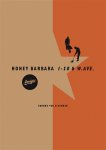Stel een vraag
Met het formulier hier onder kunt u contact op nemen met boekwinkel Mika Ela.
Rudy vander Lans - Emigre 60 - Honey Barbara: I-10 & W. AVE. (2001)
De vraag gaat over de volgende titel:
| Afbeelding: |

|
|---|---|
| Schrijver: | Rudy vander Lans |
| Titel: | Emigre 60 - Honey Barbara: I-10 & W. AVE. (2001) |
| ISBN: | |
| Uitgever: | Emigre |
| Bijzonderheid: | met CD |
| Prijs: | € 15,00 |
| Meer info | Emigre is on the move again. With this issue we have changed our magazine format and editorial direction by selecting a compact disc as the main content. We're proud to start off this next phase of the Emigre magazine saga with the release of Honey Barbara's second album I-10 & W.AVE. Years in the making, and created in near solitude deep in the heart of suburban San Antonio, these eccentric Texans, who do not tour nor make videos, and who are stubbornly non-commercial, produce music simply to keep their sanity. I-10 & W.AVE. is presented in a custom made cardboard package (6 x 8.5 inches) which also holds a 64-page mini magazine featuring a number of graphic and typographic projects?visual remixes and previews (singles?) of recent and upcoming Emigre Music releases. Typeface design and development remains central to our activities. With this issue we continue to use Emigre magazine as both a testing ground for new fonts?such as Los Feliz designed by Christian Schwartz?and as a type specimen for our existing library of typefaces. Emigre (ISSN 1045-3717) was a graphic design magazine published by Emigre Graphics between 1984 and 2005; it was first published in 1984 in San Francisco, California, USA. Art-directed by Dutch-born Rudy VanderLans using fonts designed by his wife, Czechoslovakian-born Zuzana Licko, Emigre was one of the first publications to use Macintosh computers and had a large influence on graphic designers moving into desktop publishing (DTP). Its variety of layouts, use of guest designers, and opinionated articles also had an effect on other design publications. The focus of Emigre was both redundant and wandering — both positive qualities as a journal produced by a tight and evolving group of designers and writers with Vanderlans at the center. Vanderlans was typically editor, though guest-editors also appeared (Gail Swanlund, Anne Burdick, Andrew Blauvelt) and the work/writing of Zuzana Licko and Jeffery Keedy reappeared throughout the magazine's history. The magazine began in 1984 with a focus on the émigré. The first eight issues were concerned with boundaries, international culture, travel accounts and alienation (as the issues' titles suggest). The first eight issues also incorporated a dynamic aesthetic that caught the attention of designers and led to the next stage in the magazine's evolution. Beginning with Issue 9 — devoted to the art of Vaughan Oliver at 4AD — the magazine explored design in itself, devoting issues to Cranbrook, the Macintosh, type design and individual graphic designers. In two issues in 1992 and 1993, the magazine chronicled the work of David Carson and Raygun. Increasingly, Emigre became a platform for essays and writings on design. This aspect of Emigre came to the forefront with issues in 1994 and the magazine changed its format in 1995 from its oversized layout to a text-friendlier format that debuted with Issue 33. The magazine retained this character through Issue 59 in 2001. Emigre then took a sharp turn with four re-formatted issues in 2001 and 2002 that included one DVD ("Catfish," an experimental documentary film on the work of designer and performance artist Elliott Earls) and three compact discs (featuring the music of Honey Barbara, The Grassy Knoll and Scenic). In its fifth and final incarnation, the last six issues of Emigre were co-published by Princeton Architectural Press as small softcover books. The last issue, The End, was published in 2005. |
| Boek bekijken | |
De verkoper zal binnen 3 werkdagen contact met u opnemen om de koop verder af te handelen.
